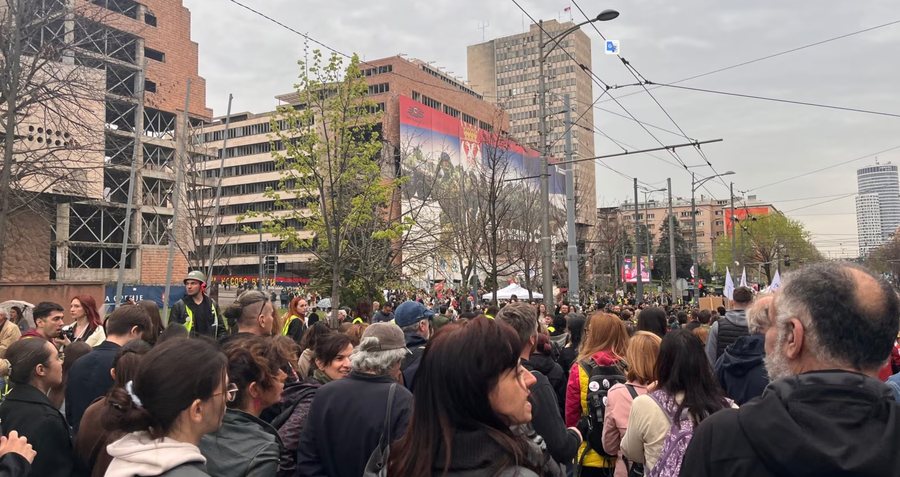
Twenty-six years after the NATO bombing of the Federal Republic of Yugoslavia, the narrative of thousands of civilians killed, as well as members of the armed forces, remains widespread in Serbia.
This was also seen in the protest organized by students in Belgrade, in front of the former General Staff building, on March 24 - the 26th anniversary of the start of the bombing.
The rally call, which the students published on the Instagram page "Students in the Blockade", stated that during the 78 days of bombing, 2,500 civilians and 1,031 members of the army and police were killed, A2 reports.
They referred to data from the Serbian Ministry of Defense, according to which 89 children also lost their lives in the bombings.
These data, with some variations, have been mentioned over the years in official ceremonies marking the anniversaries of the beginning of NATO's intervention.
According to data from the Humanitarian Law Center (HLC), a total of 756 people have lost their lives during almost three months of bombing.
Of these, 451 were civilians, including 217 Albanians, 204 Serbs and 30 Roma or members of other ethnic groups.
As for the victims from the armed forces, 276 were members of the Yugoslav Army or the Serbian MUP, while 29 were members of the Kosovo Liberation Army.
"This is the most reliable data on the victims of the NATO airstrikes in 1999. For years we have invited the public, if anyone has any information about any victims, to give it to us, but no one has come forward," Natasa Kandic, founder of the Humanitarian Law Center, tells Radio Free Europe.
In a report published in 2014, the victims' names and surnames, ethnicity, date of birth, as well as the place and date of death were presented.
What have Serbian officials said?
The data on the number of victims presented by the Serbian state leadership over the years have changed.
Serbian President Aleksandar Vučić, marking the 25th anniversary of the start of the bombing in 2024, stated that 79 children and 2,500 people were killed - "not only civilians, but also soldiers and police officers."
In a speech before the United Nations General Assembly in September 2023, Vučić said that several thousand civilians and soldiers were killed in '99.
At a memorial event, on the occasion of the NATO bombings in 2021, it was said that around 4,000 civilians were killed.
This number was slightly different in 2017, when Vučić stated that more than 2,000 civilians and almost 1,000 soldiers and police officers had been killed.
The coordinator of the National Convention for the European Union, Bojana Selakovic, emphasizes that the narrative of 2,500 civilians killed and over 1,000 soldiers killed has persisted due to the fact that there is no state data on the number of victims.
"No government has done this since 1999," says Selakovic, recalling that the only research was conducted by the Humanitarian Law Center.
According to her, the narrative of a larger number of victims is used to mobilize people on the basis of national sentiment.
"This is a frequent practice - to talk about numbers without official evidence, not to talk about facts, but about some kind of construct, construction, in order to keep alive that dimension of the victim, which, in fact, is essential in that narrative and serves for a kind of manipulation of people," she says.
Generations that don't remember the bombings
The narrative of thousands of civilians killed has also been continued by students in the blockade.
Student Dunja Stanojkovic read the statement, which stated that "on March 24, 1999, a country was bombed, and to this day no one has claimed responsibility."
"It became clear that the principles of international law do not apply equally to everyone," the students' statement said.
Radio Free Europe was unable to obtain a written response from the "Students in the Blockade" group regarding how they are informed about events related to the NATO bombings in 1999, and whether they are aware of the data published by the Humanitarian Law Center.
Bojana Selakovic believes that the students in the blockade have decided to come out with this information in order to gather a larger number of people in the protest in front of the General Staff.
She emphasizes that the narrative about the bombings is spread by the government and recalls that it concerns generations that do not remember that period.
"They have learned about this from state narratives, they have learned in schools, because this is the narrative that is used in the education system... they have also learned about this from the media. Considering that, in a way, they have been subjected to the mechanisms that the government has used all these years to discredit people in the public space, they simply do not consider other sources relevant," Selakovic explains.
Kandic believes that younger generations know almost nothing about the suffering of the non-Serb population during the NATO bombing, so they do not even question the information presented by Serbian officials.
"They don't know that there is other data that is verified by name and surname, in addition to the numbers given by representatives of state institutions," says Kandic.
Even fewer, according to her, know about the war crimes committed by members of the Serbian army and police against Kosovo Albanians in the war of 1998 and 1999.
NATO's intervention began after reports of crimes committed by Serbian police and military units against Albanian civilians in Kosovo.
The intervention was carried out without the approval of the United Nations Security Council - which set a precedent.
Serbia's official narrative only emphasizes this aspect, while nothing is said about the systematic persecution of the Albanian population in Kosovo.
The crimes of Serbian forces have been proven by verdicts from the Hague Tribunal.
Kandic says he hopes a time will come when younger generations will begin to question the official narrative about the war in Kosovo and the 1999 bombings.
"I think it is extremely important that these young people are oriented towards data and facts proven through research and that have been derived from a careful analysis of all court documents. Through social networks, I have invited them to join some of our new projects, which will help them precisely in gaining knowledge about the wars of the '90s," says Kandic.
Humanitarian Law Center Research
The Humanitarian Law Center began researching the victims immediately after the NATO bombings. According to Kandic, the researchers have gone through 35,000 sources. The first data published by the center is based exclusively on media sources.
"Back then, the media published official data that had to be approved beforehand. These media sources were focused only on victims in central Serbia. There was no data indicating that there had also been attacks on Albanians in Kosovo," says Kandic.
She adds that later research has found that the number of victims was somewhat higher among the Albanian population. According to the founder of the Humanitarian Law Center, they lost their lives mainly under special circumstances.
"Usually it was about columns of the population that had previously been deported to Albania. These columns were always under police escort. This was never talked about in the media and no representative of the authorities in Serbia mentioned the Albanian victims of the airstrikes," says Kandic.
The data on the children killed also speaks to how the official narrative of the Serbian state is selective regarding victims during the bombings.
According to data provided by state officials, the number of children killed ranges from 79 to 89. Children of Albanian nationality, in this case, are usually not mentioned at all.
Data from the Humanitarian Law Center shows that a total of 81 children under the age of 16 have lost their lives as a result of NATO bombings.
The largest number of victims in an attack was recorded on May 13, 1999, in the village of Korishë in Kosovo, where 29 children were killed.
"So far it has been established that all those children were from villages from which the Albanian population had been expelled. They had headed towards the border with Albania. The Serbian police had directed them to an old military building to spend the night there and to continue their journey to Albania the next day. During the night, the NATO airstrike took place," says Kandic.
Selakovic emphasizes that if the state were to publish the names and surnames of those killed during the bombings, it would be seen that a considerable number of them were Albanians.
"Then the narrative would fall that NATO's victims are only Serbs and that NATO is an organization directed against Serbs. We know how this narrative has been used throughout these 20 or so years - to clearly orient the course of Serbia's foreign policy," says Selakovic.
Veterans and students
In the protest in front of the former General Staff, students and citizens were joined by veterans of the 63rd Parachute Brigade. They have previously supported the student protests, which began at the end of November.
Members of the veterans' association also offered assistance to students in maintaining order during the large protest in Belgrade on March 15, when several hundred thousand people gathered in the capital.
"Given that those units have a reputation for protecting national interests, students probably don't see anything wrong with their involvement. They're just not informed about what those people have done and how problematic it has been," says Selakovic.
Members of the 63rd Parachute Brigade participated in all wars in the former Yugoslavia during the 1990s.
According to data from the Humanitarian Law Center, court verdicts mention their participation in the "Reka" operation in April 1999.
During this action, the most massive crime in Kosovo occurred, when over 300 members of the Albanian community from the village of Mejë were separated from their families and killed on the road to Gjakova.
The verdicts against then-Yugoslav Army generals Nebojša Pavković and Vladimir Lazarević for war crimes against Albanian civilians do not mention the responsibility of the commanders or chiefs of staff of the 63rd Parachute Brigade. In those indictments, the focus was on the military leaders of the Yugoslav Army.
The rally in front of the General Staff was part of months of protests in Serbia demanding responsibility for the deaths of 16 people from the collapse of a concrete roof at the Novi Sad Railway Station.
The protests are being led by students, who, for more than four months, have been blocking dozens of faculties across Serbia. (A2 Televizion)











